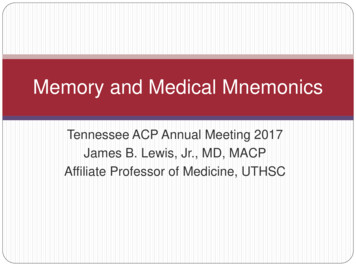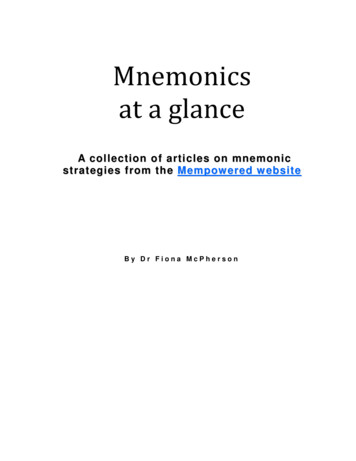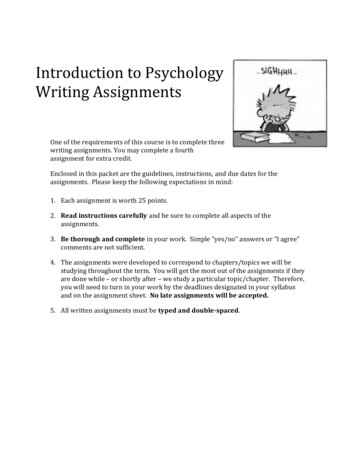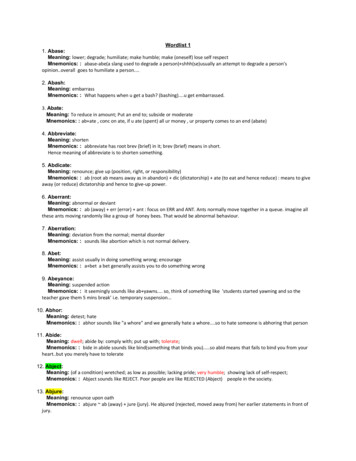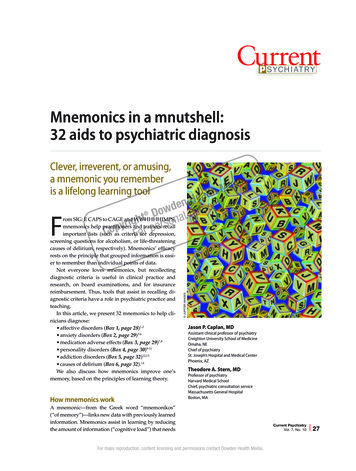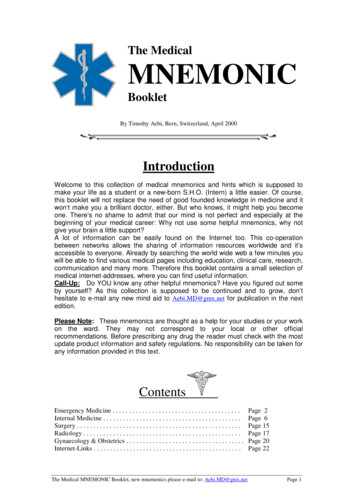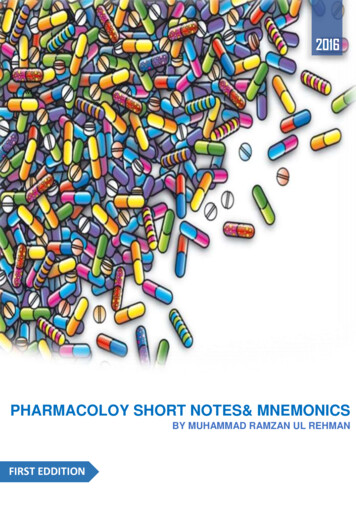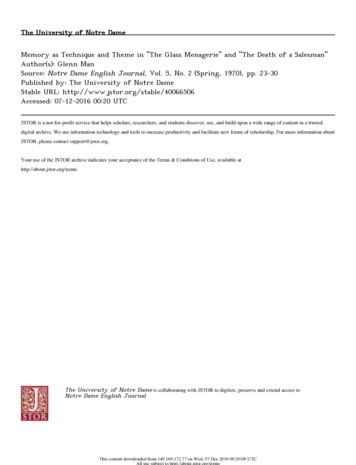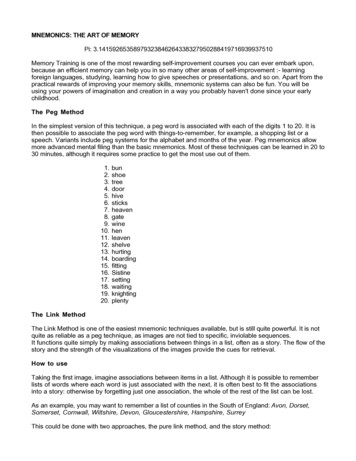
Transcription
MNEMONICS: THE ART OF MEMORYPi: 10Memory Training is one of the most rewarding self-improvement courses you can ever embark upon,because an efficient memory can help you in so many other areas of self-improvement :- learningforeign languages, studying, learning how to give speeches or presentations, and so on. Apart from thepractical rewards of improving your memory skills, mnemonic systems can also be fun. You will beusing your powers of imagination and creation in a way you probably haven't done since your earlychildhood.The Peg MethodIn the simplest version of this technique, a peg word is associated with each of the digits 1 to 20. It isthen possible to associate the peg word with things-to-remember, for example, a shopping list or aspeech. Variants include peg systems for the alphabet and months of the year. Peg mnemonics allowmore advanced mental filing than the basic mnemonics. Most of these techniques can be learned in 20 to30 minutes, although it requires some practice to get the most use out of ingknightingplentyThe Link MethodThe Link Method is one of the easiest mnemonic techniques available, but is still quite powerful. It is notquite as reliable as a peg technique, as images are not tied to specific, inviolable sequences.It functions quite simply by making associations between things in a list, often as a story. The flow of thestory and the strength of the visualizations of the images provide the cues for retrieval.How to useTaking the first image, imagine associations between items in a list. Although it is possible to rememberlists of words where each word is just associated with the next, it is often best to fit the associationsinto a story: otherwise by forgetting just one association, the whole of the rest of the list can be lost.As an example, you may want to remember a list of counties in the South of England: Avon, Dorset,Somerset, Cornwall, Wiltshire, Devon, Gloucestershire, Hampshire, SurreyThis could be done with two approaches, the pure link method, and the story method:
The Link MethodThis would rely on a series of images coding information:*******An AVON (Avon) lady knocking on a heavy oak DOoR (Dorset).The DOoR opens to show a beautiful SuMmER landscape with a SETting sun (Somerset).The setting sun shines down onto a field of CORN (Cornwall).The CORN is so dry it is beginning to WILT (Wiltshire).The WILTing stalks slowly fall onto the tail of the sleeping DEVil (Devon).On the DEVil's horn a woman has impaled a GLOSsy (Gloucestershire) HAM (Hampshire) whenshe hit him over the head with it.Now the Devil feels SoRRY (Surrey) he bothered her.Note that there need not be any reason or underlying plot to the sequence of images: all that is importantare the images and the links between images.The Story MethodAlternatively this information may be coded by vividly imaging the following scene:An AVON lady is walking up a path towards a strange house. She is hot and sweating slightly in theheat of high SUMMER (Somerset). Beside the path someone has planted giant CORN in a WALL(Cornwall), but it's beginning to WILT (Wiltshire) in the heat. She knocks on the DOoR (Dorset), which isopened by the DEVil (Devon). In the background she can see a kitchen in which a servant is smearinghoney on a HAM (Hampshire), making in GLOSsy (Gloucestershire) and gleam in bright sunlightstreaming in through a window. Panicked by seeing the Devil, the Avon lady panics, screams 'SoRRY'(Surrey), and dashes back down the path.Given the fluid structure of this mnemonic, it is important that the images stored in your mind are as vividas possible, and that significant, coding images are much stronger that ones that merely support theflow of the story. See the section on using mnemonics more effectively for further information on makingimages as strong as possible.The Major SystemThe Major Memory System is one of the two most powerful memory systems currently available. Itrequires an investment of time to learn and master, however once it is learned it is extremely powerful. Itis the application of mainly this system that forms the basis of some of the extraordinary, almost magical,memory feats performed by magicians and memory technicians.How to useThe system works by converting number sequences into nouns, nouns into images, and linking imagesinto sequences. These sequences can be very complex and detailed.The building blocks of the system are the association of the numbers below with the followingconsonant sounds:0 - s, z, soft-c - remember as 'z is first letter of zero'1 - d, t, th - remember as letters with 1 downstroke2 - n - remember as having 2 downstrokes3 - m - has three downstrokes
4 - r - imagine a 4 and an R glued together back-to-back5 - L - imagine the 5 propped up against a book end (L)6 - j, sh, soft-ch, dg, soft-g - g is 6 rotated 180 degrees.7 - k, hard-ch, hard-c, hard-g, ng - imagine K as two 7s rotated and gluedtogether8 - f, v - imagine the bottom loop of the 8 as an eFfluent pipe dischargingwaste (letter image of F in alphabet system)9 - p, b - b as 9 rotated 180 d-gjqsoft-cThese associations really must be learned before proceeding.The system operates on a number of levels, depending on the amount of time a user is prepared todevote to learning the system. The first level, the coding of single digit numbers into consonants andsmall words, functions almost as a poor relation of the number/rhyme system. It is at higher levels thatthe power of the system is unleashed, however this level must be assimilated first.The trick with the conversion into words is to use only the consonants that code information within theword, while using vowels to pad the consonants out with meaning. By choosing letters for your word inthe preferential order AEIOU you stand a better chance of being able to reconstruct the image word ifyou forget it. 0barrel945PEG WORDS BASED ON THE MAJOR SYSTEM
1. tie hat2. noah hen3. Ma ham4. rye hair5. law hill6. shoe shoe7. cow hook8. ivy hoof9. bee hoop10. toes dice11. tot deed12. tin den13. tomb dam14. tire deer15. towel doll16. dish dish17. tack deck18. dove dove19. tub dope20. nose newsUsing Mnemonics to Learn More EffectivelyWhen you are creating a mnemonic, e.g. an image or story to remember a telephone number, the followingthings can be used to make the mnemonic more memorable:*Use positive, pleasant images. The brain often blocks out unpleasant ones.*Exaggerate the size of important parts of the image*Use humour (perhaps linked with point 2)! Funny or peculiar things are easier to remember thannormal ones.*Similarly rude or sexual rhymes are very difficult to forget!*Symbols (e.g. red traffic lights, pointing fingers, etc.) can be used in mnemonics.*Vivid, colourful images are easier to remember than drab ones.*Use all the senses to code information or dress up an image. Remember that your mnemonic cancontain sounds, smells, tastes, touch, movements and feelings as well as pictures.*Bringing three dimensions and movement to an image makes it more vivid. Movement can be usedeither to maintain the flow of association, or can help to remember actions.*Locate similar mnemonics in different places with backgrounds of those places. This will help to keepsimilar images distinct and unconfused.The important thing is that the mnemonic should clearly relate to the thing being remembered, and that itshould be vivid enough to be clearly remembered whenever you think about itBooks:Super Memory - Super Student : How to Raise Your Grades in 30 Days by Harry LorayneThe Memory Book : The Classic Guide to Improving Your Memory at Work, at School, and at Playby HARRY LORAYNE, JERRY lhttp://www.vlaardingen.net/ tom/Mainmenu.htm
Paul Cezanne1895
Memory Training is one of the most rewarding self-improvement courses you can ever embark upon, because an efficient memory can help you in so many other areas of self-improvement :- learning . Books: Super Memory - Super Student : How to Raise Your Grades in 30 Days by Harry Lorayne The Memory Book : The Classic Guide to Improving Your .

